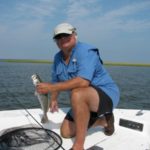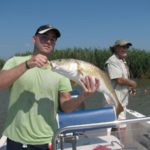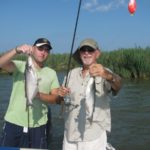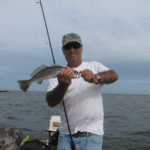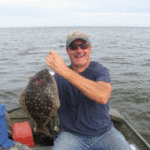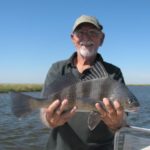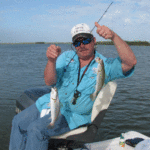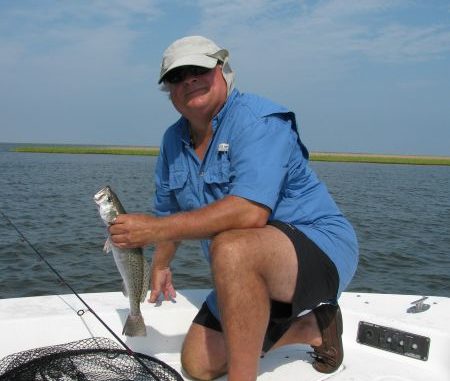
Now you can save on fuel costs AND fill the boat with a variety of fish.
May loomed, and Eddie assumed our traditional summer fishing schedule also loomed.
“Guess we’re driving down to the mouth of the river next week,” he frowned. “What a haul! Then motoring downriver to fish the canes along Redfish Bay, Blind Bay, Customhouse, etc. — another HAUL!”
Pelayo looked at Eddie, then around to the rest of us on Doc’s gazebo.
“You missed a few years of tradition with your exile up north after your disbarment, Eddie. You’re forgetting that … .”
Eddie winced at Pelayo’s stressing of “disbarment,” then gulped deeply from his Big Gulp, which we knew had been heavily spiked at Doc’s liquor cabinet.
“And man!” he continued, ignoring Pelayo. “With these gas prices, we’re looking at a trip pushing a couple hundred dollarinies, donuts, big ones (here he went into his Steve Martin as The Jerk routine). Hope at least four of us are going to spread and cushion the cost!”
“Eddie if you’d KINDLY listen,” Pelayo corrected. “You’ll learn that … .”
“I mean — great fishing and everything this time a year down there. Don’t get me wrong,” Eddie pressed ahead. “No better area for guaranteed reds. I ain’t saying it ain’t. But still! I mean maybe we oughta … .”
“You got it WRONG, Eddie!” Pelayo finally got a word in edgewise. “Didn’t you hear? Venice moved north!”
With that, most of the heads in the patio and yard around us turned to Pelayo, including Doc and Spencer and even Trish and Priscilla.
“So listen up, class,” Pelayo said, adopting a professorial tone. “It don’t take nearly as long to get to great redfishing in a marsh flushed with nutrient-rich, grass-growing, bait-producing — and cool — river water anymore.”
Pelayo looked around acknowledging the attention he’d attracted, whipped out his iPad and went to Google maps.
“Dig it!” he said pointing to it.
We all crowded around for a look.
“See here,” and he pointed at Bayou Lamoque, just across the river from Empire. “These gates were opened right after the BP spill, and river water rushed through toward Breton Sound, like it did traditionally, before the levee went up in the 1920s.
“Now let’s travel south,” Pelayo pointed on his iPad. We were all eyes and ears again. Priscilla was pressing closely against my back while looking over my shoulder — and I wasn’t complaining.
“The Ostrica locks were opened too.” Pelayo picked up his lecture. “They’ve been rebuilt and are operating again. But right here below it is a natural cut that’s always open. Now moving downriver toward Baptiste Collette, look how many little spillway we got spilling river water into the marsh nowadays. And most of these natural cuts have been open for almost 15 years.
“In other words, what used to be an abrupt change in the landscape when you got to Baptiste Collete — you know, the roseau, elephant ear, duck potato, peavine, willow type of marsh you find from Baptiste all the way down to the rocks at South and Southwest passes — this type of marsh has moved north, due to these natural spillways and river diversions.”
“Used to be,” Chris interrupted with a wink my way as Trisha pressed up against his back for a closer look. “Used to be that we’d do great in the Quarantine Bay/Ostrica area marsh-fishing for reds, puppy drum, flounder, sheepshead, school specks, etc. until roughly around Memorial Day. Then when the heavy summer heat really kicked in and the water warmed up, the marsh fishing slowed down for us … .”
“And just when it was really kicking in for most of the people who cross the river at Ostrica.” Pelayo chimed back in. “Because most of these are seeking big specks with live bait around Battledore, Central and the other Rigs in Breton Sound. We’d always wave to them on their way out while we were battling reds in this shallow-water marsh. Then around late May we’d move south to the mouth of the river. Our theory was always that the cooler river water and the shade and structure from the rouseau canes accounted for the better summer fishing down there. But who knows? Maybe it was the richer vegetation and bait-producing river water. Whatever. All of that has moved north … .”
“Oh, man!” Eddie moaned again. “But I hate having to wait for those doggone locks to open! Always takes so long … such a pain in the … .”
“That’s also changed,” Chris said while Trish pressed ever closer for a look and he rolled his eyes dreamily. “See here — see the cut Pelayo mentioned right below the locks? Well, nowadays, we just scoot right through it and into the marsh, hang the first left into Bayou Tortillon and — voila! — we’re in Quarantine Bay! Nothing to it!”
And so it came to pass two days later. Four of us in Eddie’s new bay boat all right — to cushion gas expense for sure but also because all four of us wanted to get into some dy-no-mite fishing. Not that spreading the cost didn’t help!
Fish this marsh (roughly from California Point on the north to Deepwater Point on the south) on a high (the higher, the better) and falling tide, and you can’t go wrong — especially for reds. Also throw in some puppy drum, flounder, sheepshead and a smattering of school specks and white trout.
After an uncharacteristically short boat-trip for coastal Louisiana fishing, we cast into some classic marsh fishing, in the By Hek tradition. When fishing out here, do yourself a favor and leave the gold spoons, Top Dogs and fly rods home, please. Instead, bring the white or chartreuse (when sunny) or purple (when overcast) beetles, popping corks and market bait. Cast them toward the flooded coastline wherever you find 2-foot depths or so, and moving water close to the bank, certainly around spartina grass, but also along the stands of roseau cane now sprouting up in the area. Finding an oyster-dotted bottom in the northern reaches also helps.
The northern reaches close to the sound are shallow, oyster-studded marsh, which is why the reds love it. Open their stomachs, and you’ll find mainly crabs — not blue crabs but tiny stone crabs. These infest the nooks and crevices in oyster reefs. The reds prowl the reefs, sucking them down. Further west (closer to the river) around Bucks Bay and south around Bay Denesse, beds of milfoil and coontail provide the bait-holding “structure.” Fishing along these grass beds, as in the Grand Lake area in Delacroix and Little Lake area in Lafitte, usually yields a few chunky redfish. In addition, nowadays tasty blue cats often grab the jigs, especially when tipped with shrimp.
Most people who launch from Venice and cross the river fish up to Taylors Point, maybe Deepwater Point. Those who launch from Pointe a la Hache, fish down to Spanish Pass or California Point. Those who launch into the river at Buras generally cross the locks and keep heading out to Battledore or Breton Sound. Obviously, exceptions exist, but the pattern seems to hold, in our experience.
Fine. Be my guest. That’s the beauty of this section of marsh — no crowds.
And this is a pretty big section of marsh to fish almost unmolested. A marsh that features big open bays (Quarantine, Bucks), smaller bays (Allen, Denesse, which stay fairly calm and clear even with blustery east winds) a maze of bayous and canals to aid access, and a stretch of coastline bordering Breton Sound featuring points (California, Raccoon, Deepwater), which on calm days offer classic cork-fishing for trout, often under birds.
That’s the beauty of this area — the options. You can go from casting live bait or plastic around a well in Breton Sound to corkfishing with tandem beetles under birds around a point or island to fishing around the oyster poles in Allen Bay to casting for reds and flounder along the grassy shoreline of Cuselich Bay — all in a couple of hours without traveling more than a few miles.
I was dropping the anchor along the north shore of Quarantine Bay when Eddie sent a shrimp-tipped beetle 2 feet under a popping cork to the grassy tip of a feeble spartina-grass island, backed up by a wall of roseau. The place had redfish written all over it. The cork splashed about 2 feet from a white PVC pole, and never reappeared.
“Hey what the … ?” Eddie was frowning, mumbling something about his twisting line when — “WHOOA! That’s him!”
He reared back on the light-action rod, and the battle was joined. No tight drags and stiff bass rods for us. We like to play fish, to feel those lunges, to savor the screeching runs of a berserk red in shallow water. And, mostly, to listen to the scream of a loose drag on a spinning reel.
Eddie’s pole seemed on the verge of splintering and his face was a mask of sheer delight as that bronze torpedo blazed through the shallows. From its wake, you could tell it was a beauty. Probably 5 to 7 pounds. I grabbed the net just as Pelayo let out a whoop. He was on one too, and Chris was reeling in a school speck from a current line about 50 feet from the grassy shoreline where a tern had just smacked the water.
I netted Eddie’s fish to a chorus of hurrahs accompanied by high-fives as Pelayo placed his along the Cajun Computer, stretching him, closing his tail for that extra half-inch.
“Aha!” he beamed. “Seventeen and one-quarter inches. A keeper!” Then he ducked as Chris swung aboard what was actually a white trout, which are showing up more abundantly in this area lately. And no complaints from us.
Both the rat-red and the trout would fry up gorgeously, perhaps whole, with the crispy, garlicky skin encasing the moist white meat underneath. These rat reds, as we all know, fry best. And white trout, for whatever reason, seem to carry much fewer of those unsightly spaghetti worms so common to their speckled cousins.
I finally cast out about 10 yards from the bank in slightly deeper water. I had a white beetle “sweetened up” with half a shrimp 3 feet under a popping cork.
The current was taking it, and on the third pop it plunged. I struck back, and he hit the surface thrashing that yellow mouth.
“Trout!’ I bellowed. “We’re on ’em!”
Within seconds, two corks landed just yards from my trout. And within a few more seconds, those two plunged. Two school specks were soon thrashing on the surface, as Pelayo battled another red that was aiming for deep water.
“Probably a big ‘un!” Chris yelled as he unhooked his trout. “Dey always do that!”
The action finally slowed, so we cranked it up and headed east through an old silted-up pipeline canal into the broken island studded marsh some maps label Cuselich and Pierre Bays.
The tide was moving, and you could see the little eddies around each point, which had milfoil sprouting from the muddy bottom. I peeked astern, and made out the bottom of the prop through the hazy water. Perfect redfish water. Just then, a tern smacked the water around the little eddies formed by the outgoing current about 20 yards astern.
“Saw that?” Pelayo asked as his cork sailed toward the action. I turned to see another tern smack near shore, then heard Pelayo’s grunt. A red exploded in a copper froth on the surface as his pole bowed.
In minutes Eddie and Chris were on the bow tussling with what we thought were more school specks or rat reds — but in fact were blue cats, about a pound each.
“Courtesy of all that rivah water!” Eddie whooped as he chunked his in the box. “These fillets are gonna be dy-no-mite!”
I cast where Pelayo had been a second before, looked back and felt a tug. I looked back. No cork anywhere. Another tug. So I reared back. YES!!
Is there a more magnificent sensation, my friends? I felt a solid WHUMP, then a sharp lunge as the reel started screaming.
“Red!” I howled just as he erupted in a foaming copper swirl. “A monster!”
My line was sizzling out. This brute plowed through the milfoil (erroneously called hydrilla), then turned and aimed for the open water, such as it is in this area. Classic bull-red tactic.
I cranked furiously and tightened it just as it plowed under the anchor line. Somehow I passed the pole under the anchor rope and breathed a sigh of relief when I felt his bulk on the end of the line.
Then he went on another run. I stood on the bow, pole overhead, savoring every sizzling second of the maniac’s run. Looking over for applause, I saw Pelayo beaming as he swung in a flounder from the current-washed point, which is a typical locale for these delicious fish.
“Check it out!” Chris was pointing toward his cork; a small alligator was heading for it, so he quickly reeled in. Here was more evidence of the freshening process from river water recently.
After we boated and released my bull red (not common for us, but we already had plenty smaller ones), we worked around another point with shrimp-tipped beetles — not with a trolling motor and topwater or spinnerbaits, but anchoring and covering the shoreline with shrimp-tipped beetles under popping corks — we caught another four reds. A half-dozen more school trout along with two white trout, a sheepshead, three puppy drum and two more flounder also prettied up the box.
We didn’t encounter another boat while fishing. But when heading back, a parade of them were coming in from the open waters of Breton Sound. Eddie was all smiles as he pointed at them — then at his gas gauge. We knew what he was thinking. Our round trip had barely topped six miles.
